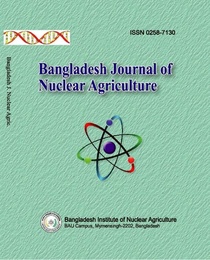AREA COVERAGE OF BINA DEVELOPED RICE, PULSE, OILSEED AND HORTICULTURAL CROP VARIETIES IN BANGLADESH
Abstract
The study was conducted to assess the area coverage of BINA developed rice, pulse, oilseed and horticultural crop varieties during 2022-23. Field survey data were collected from 64 districts through concern DD, DAE office. Both tabular and descriptive statistical analysis was used. It was observed that the overall area coverage of BINA developed rice varieties were 8.91%. Among the three seasons; Aus, Aman and Boro the highest area coverage was found in Aman season that was 14.54% followed by Aus 5.95% and Boro 2.93%, respectively. Among the 14 agricultural regions the highest area coverage of rice was found 15.41% in Rajshahi region (Reg-7) and the lowest was found 1.01% in Dhaka region (Reg-11). The overall area coverage of BINA developed pulse varieties were 16.32% and among the 14 regions the highest area coverage for pulses was found in Barishal region 58.51% (Reg-6). The overall area coverage of BINA developed oilseed varieties were 23.46% and among the 14 regions the highest area coverage for oilseed was found in Jashore region 16.32% (Reg-13). Among the BINA developed horticultural varieties the highest area coverage was found 4.46% for Binalebu-1 followed by Binahalud-1 (0.93%) and Binatomato-10 (0.36%). It was also observed that, among the 14 regions the highest area coverage for Binalebu-1 and Binahalud-1 were found in Rangamati agricultural region (region-4) about 483 ha (87.26%) and 45 ha (18.19%), respectively. The study identified that the overall area coverage of BINA developed rice, pulse and oilseed crops for distributed seed were 0.93%, 1.41% and 3.45%, respectively. The study also observed some constraints such as-non availability of seed, lack of training, demonstrations, field day, collaboration etc. For continuation of variety expansion, the institute should ensure quality seed supply in proper time and training, demonstration as well as collaboration among other research institutes, DAE, BADC and NGOs should be emphasized.
References
BBS (Bangladesh Bureau of Statistics). 2022. Year Book of Statistics of Bangladesh. Ministry of Planning, Govt. of the Peoples’ Republic of Bangladesh. Dhaka.
BBS (Bangladesh Bureau of Statistics). 2021. Year Book of Statistics of Bangladesh. Ministry of Planning, Govt. of the Peoples’ Republic of Bangladesh. Dhaka.
Masangano, C. M., and Miles, C. A. 2004. Factors Influencing Farmers’ Adoption of Kalima Bean (Phaseolus vulgaris L.) Variety in Malawi. Journal of Sustainable Agriculture, 24(2): 117-129.
Rahman, M. H., Sultana, R., Sarkar, M. M. A. and Islam, S., Sivasankar, S. 2022. Determinants of adoption and preferences for Aman rice mutant variety Binadhan-7 cultivation in Bangladesh. Archives of Agriculture and Environmental Science, 7(4), 595-600.
Rahman, M. H., Sarkar, M. M. A., Islam, S. and Sultana, R. 2021. Farmers Level Adoption of BINA developed crop varieties in Mymensingh region of Bangladesh. Bangladesh Journal of Nuclear Agriculture, Vol. 35: 167-176.
Rogers, E. M., 2003. Diffusion of Innovations (5th ed.) New York: Free Press. P 512.
Röling, N., 1988. Extension Science, Information Systems in Agricultural Development. Cambridge University Press. P 233.
Year book of Agricultural Statistics, 2022. Bangladesh Bureau of Statistics. Statistics and Information Division. Ministry of Planning, Dhaka.
-
Download



